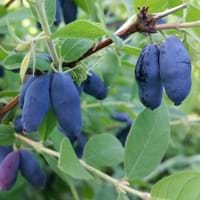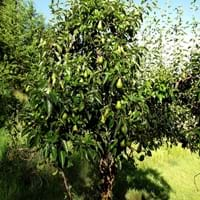Life Span
Perennial
Perennial
Type
Flowering Plants, Shrubs
Fruit
Origin
Asia, North America
Europe, Western Asia
Types
Lonicera caerulea altaica, Lonicera caerulea cauriana, Lonicera caerulea kamschatica
Green Anjou, Red Anjou, Bartlett
Habitat
Wet lands
Humid climates, moist forests
USDA Hardiness Zone
Not Available
3-8
AHS Heat Zone
Not Available
9-5
Sunset Zone
Not Available
2a, 2b, 3a, 3b, 4, 5, 6, 7, 8, 9, 14, 15, 16, 17, 18
Habit
Cushion/Mound-forming
Oval or Rounded
Flower Color
Yellow
White
Flower Color Modifier
Bicolor
Not Available
Fruit Color
Brown
White, Yellow, Red, Green, Yellow green
Leaf Color in Spring
Dark Green
Light Pink, Red, Green, Light Green
Leaf Color in Summer
Blue Green, Gray Green
Dark Green
Leaf Color in Fall
Blue Green, Gray Green
Purple, Dark Green, Burgundy
Leaf Color in Winter
Blue Green, Gray Green
Light Green
Leaf Shape
Oval
Oval with a pointed tip and fine teeth along their edges
Plant Season
Summer, Fall, Winter
Early Spring, Winter
Sunlight
Full Sun, Partial shade
Full Sun
Growth Rate
Medium
Medium
Type of Soil
Well drained
Loamy, Sandy
The pH of Soil
Neutral
Acidic
Soil Drainage
Well drained
Well drained
Bloom Time
Late Winter, Spring, Summer
Fall, Summer
Tolerances
Drought
Drought
Where to Plant?
Ground
Ground
How to Plant?
Seedlings
Grafting, Seedlings
Plant Maintenance
Medium
Low
Watering Requirements
Get enough water whenever the soil is dry
Medium, Water less during winter, Water more in summer, when new, water every week
In Summer
Lots of watering
Lots of watering
In Spring
Moderate
Moderate
In Winter
Average Water
Average Water
Soil pH
Neutral
Not Available
Soil Type
Well drained
Not Available
Soil Drainage Capacity
Well drained
Not Available
Sun Exposure
Full Sun
Full Sun, Partial Sun
Pruning
Prune for shortening long shoots, Remove damaged leaves, Remove dead branches, Remove dead leaves
Remove damaged leaves, Remove dead branches, Remove dead leaves
Fertilizers
All-Purpose Liquid Fertilizer
Ammonium Nitrate, Fertilize the soil before planting
Pests and Diseases
Red blotch
Red blotch
Plant Tolerance
Drought
Drought
Flower Petal Number
Single
Single
Foliage Texture
Bold
Medium
Foliage Sheen
Matte
Glossy
Attracts
Bugs
Aphids, Birds, Butterflies, Pear psylla
Allergy
Not Available
Anaphylaxis, Digestive Problems, Itchiness, Swelling
Aesthetic Uses
Showy Purposes
Cottage Garden
Beauty Benefits
Not Available
Good for skin, Improve skin tone, Making cosmetics, Moisturizing, Skin Problems
Environmental Uses
Air purification
Air purification, Shadow Tree
Medicinal Uses
anti-inflammatory, Cardiovascular problems, Eye Problems
Cancer, Cardiovascular problems, cholesterol-lowering, Detox, Diabetes, Energy, Fiber, Heart problems, High blood pressure, Obesity, Treating diverticulosis, Weight loss
Part of Plant Used
Fruits, Leaves
Bark, Fruits, Leaves
Other Uses
Food for animals, Food for insects, Used as Ornamental plant, Used for its medicinal properties
Used As Food
Used As Indoor Plant
No
No
Used As Outdoor Plant
Yes
Yes
Garden Design
Bedding Plant, Container, Edging, Edible, Herb / Vegetable, Mixed Border
Not Available
Botanical Name
Lonicera caerulea
PYRUS communis
Common Name
honeyberry, blue-berried honeysuckle, sweetberry honeysuckle
Pear
In Hindi
Honeyberry
नाशपाती
In German
Honeyberry
Birne
In French
baie au miel
Poire
In Spanish
Honeyberry
Pera
In Greek
Honeyberry
Αχλάδι
In Portuguese
Honeyberry
Pera
In Polish
Honeyberry
Gruszka
In Latin
Honeyberry
Orbis
Phylum
Magnoliophyta
Vascular plant
Class
Magnoliopsida
Magnoliopsida
Family
Caprifoliaceae
Rosaceae
Clade
Angiosperms, Asterids, Eudicots
Angiosperms, Eudicots, Rosids
Tribe
Not Available
Maleae
Subfamily
Not Available
Amygdaloideae
Importance of Honeyberry and Pear
Want to have the most appropriate plant for your garden? You might want to know the importance of Honeyberry and Pear. Basically, these two plants vary in many aspects. Compare Honeyberry and Pear as they differ in many characteristics such as their life, care, benefits, facts, etc. Every gardener must at least have the slightest clue about the plants he wants to plant in his garden. Compare their benefits, which differ in many ways like facts and uses. The medicinal use of Honeyberry is anti-inflammatory, Cardiovascular problems and Eye Problems whereas of Pear is Cancer, Cardiovascular problems, cholesterol-lowering, Detox, Diabetes, Energy, Fiber, Heart problems, High blood pressure, Obesity, Treating diverticulosis and Weight loss. Honeyberry has beauty benefits as follows: Not Available while Pear has beauty benefits as follows: Not Available.
Compare Facts of Honeyberry vs Pear
How to choose the best garden plant for your garden depending upon its facts? Here garden plant comparison will help you to solve this query. Compare the facts of Honeyberry vs Pear and know which one to choose. As garden plants have benefits and other uses, allergy is also a major drawback of plants for some people. Allergic reactions of Honeyberry are Not Available whereas of Pear have Anaphylaxis, Digestive Problems, Itchiness and Swelling respectively. Having a fruit bearing plant in your garden can be a plus point of your garden. Honeyberry has no showy fruits and Pear has showy fruits. Also Honeyberry is not flowering and Pear is flowering. You can compare Honeyberry and Pear facts and facts of other plants too.





